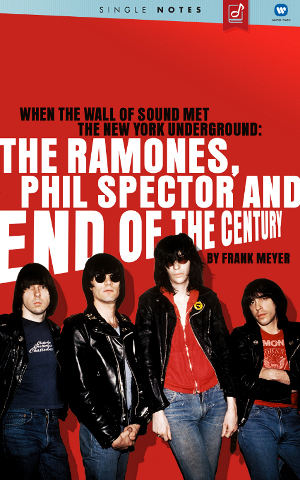As a music geek, it’s only natural that you might pile up a few rock and roll regrets along the way. For all of the great experiences you’re privy to, there are also a few that you miss out on and sometimes, you kick yourself later for the opportunities which were right there in front of you.
One of those for me is the fact that I never saw the Ramones in concert and I certainly had several chances to do so, including the band’s headlining performance at the WMMS Buzzardfest in 1995 at Blossom Music Center.
I came late to the Ramones party, but one of the first songs that really made impact with me was “Do You Remember Rock and Roll Radio” from 1980’s End of the Century.
“This is rock and roll radio/ c’mon let’s rock and roll with the Ramones” was the album opening greeting from the “DJ,” voiced by Sean Donahue, which opened the door to End of the Century. It was such a cool intro that I found it completely necessary to place it as the starting track on one of my mix tapes at one point.
It was an interesting period for the band, who were working with legendary producer Phil Spector for the first time, a move that not everybody in the group was on board with. When The Wall of Sound Met The New York Underground: The Ramones, Phil Spector and the End of the Century is the tantalizing title of a new ebook from Frank Meyer which attempts (very successfully) to shed some light and detail on the experience.
Meyer brings a good amount of cred to the table, having written liner notes for a good chunk of the Ramones reissues in recent years and additionally, he co-authored the book On The Road With The Ramones with former Ramones tour manager Monte A. Melnick.
He draws on that experience for certain tidbits and interview quotes from the members of the Ramones and their former associates, some of which are previously unpublished, to create a documentation of the End of the Century experience that is essential reading for both music fans and Ramones fans alike.
When The Wall of Sound Met The New York Underground is a musical literary dissertation in defense of both End of the Century and the related Rock ‘N’ Roll High School movie that will immediately make you want to own both if you don’t already and at the very least, you’ll be pulling out your copies to revisit them after reading it.
End of the Century was Meyer’s introduction to the band and as he recalls, it was an album which “wasn’t nearly as brutal and scathing as I thought punk rock was supposed to be.” It was this fact which left a large portion of their existing fanbase feeling really pissed off for what they viewed as their punk heroes selling out to the mainstream.
Certainly, End of the Century was indeed an attempt by the Ramones to take things in a direction which was more mass appeal, but as Meyer explains, the album doesn’t deserve the slagging that it received. It deserves in his opinion, a higher ranking within the Ramones legacy and during the course of the book, he makes a really good case to support his argument.
The band’s union with the notoriously quirky Ramone (really, we would have no idea until much later, it turns out) found the producer brandishing firearms as a way to threaten the band members into doing what he wanted them to do. But the Ramones were willing to push back, to a point.
As Marky Ramone shares, “we weren’t the Righteous Brothers – he couldn’t push us around.”
The sessions however, paired with Spector’s wild mood swings, temper tantrums and unorthodox methods of getting things done would drive some of the band members (especially guitarist Johnny Ramone) to the brink of near-insanity.
In the midst of all of this, the Ramones were also making the Rock ‘N’ Roll High School movie, which was budgeted at a very modest $300,000 that didn’t begin to cover a lot of the outside expenses associated with the film. Because of the costs of housing the band in Los Angeles while they worked on the film, they also played a number of gigs during that same time period to help offset the cost.
They certainly had a lot going on and it’s fascinating to read the tales behind the movie and the album and the high expectations attached to both, nearly all of which would fail to be realized upon completion and release
But End of the Century was a valuable experience for the band, because as Meyer writes, they grew up during the process of making the album. Calling it the album where they were “swimming with sharks” as opposed to jumping over them, End of the Century was the sound of the “greatest punk band there ever was, stretching their wings and flexing their musical muscles.”
Wall of Sound reveals that when you consider everything behind the scenes that the Ramones were facing during the making of End of the Century, they made an album that was pretty damn good. Even if there had been nothing but sunshine moments during the sessions, the Ramones created something that remains a crucial listen. When The Wall of Sound Met The New York Underground is a nice companion piece for that listening experience.
[youtube_sc url=”http://www.youtube.com/watch?v=eV6Zju0cpPM”]

Thanks..